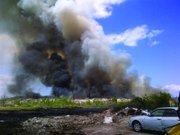FIREFIGHTERS spent yesterday attempting to extinguish a massive fire at the city dump.
Fire Chief Walter Evans said more than three fire engines were dispatched to the scene after 10am to contain the blaze.
Meanwhile, nearby residents of Jubilee Gardens had to deal with the thick black smoke that blanketed the area.
The cause of the fire is unknown, and the blaze was still raging at press time last night.





Comments
carlh57 11 years, 11 months ago
Does anyone have figures on how many city dump fires there are each year/month? I live down wind from there and could swear we have smoke every 7-10 days....something has got to happen to keep this pollution in check. It affects everyones health and quality of life.
carlh57 10 years ago
You would hope that our public officials and those responsible would stop turning a deaf ear to this and dismissing the dangers of these fires. In a report published by Waste Management World (leading waste company the the world), they emphatically state (and i am quoting directly from their report below):
"Atmospheric emissions from landfill fires are often dismissed as a nuisance. The following are two examples of just how serious the ‘nuisance’ is: Dioxin emissions: (remember the Bhopal disasterr?) The United Nations Environment Programme (UNEP) considers that for the foreseeable future, non-industrial, uncontrolled combustion, mainly comprised of landfill fires and illegal barrel burning, will remain the most significant source of persistant organic pollutants (POPs) in the form of polychlorinated dibenzo-p-dioxins (PCCDs) and polychlorinated dibenzofurans (PCCFs) in Europe (Thornton, 2002). Gases and Vapors: landfill fires emit a toxic cocktail of ‘Most Wanted’ fugitive gases including formaldehyde, hydrogen cyanide, hydrogen sulfide, nitrogen oxides and many others (OEPA, 2006). Visible smoke might not be visible since compacted waste acts as a good particulate filter, but fugitive gases are able to percolate towards the surface. Emitted smoke is a hazard and has resulted in the imposition of Civil Aviation Authority ‘no-fly’ zones. A particular problem with smoke, which is largely unburned carbon, is particles that have become activated, in the form of an adsorbent, with a huge appetite for mopping-up ‘most wanted’ contaminants. Very small particles, known as Sub PM2.5s (smaller than 2.5 millionths of a meter in diameter) are capable of remaining airborne for days, and together with adsorbed contaminants will pass directly into the bloodstream once inhaled."
Sign in to comment
Or login with:
OpenID